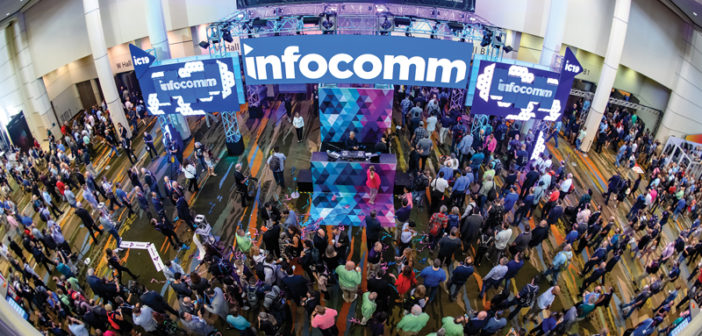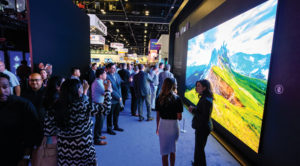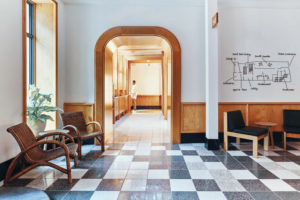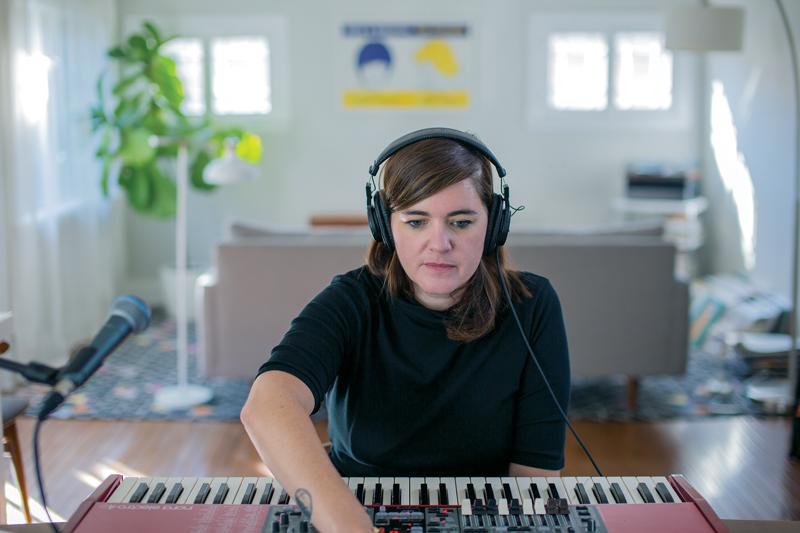ORLANDO—Walk down the aisles of InfoComm, the largest professional audiovisual trade show in North America, which was recently held here, and it’s easy to get overwhelmed. The show, produced by the Audiovisual and Integrated Experience Association (AVIXA), features some 1,000 exhibitors—many of them offering large-scale displays and screens. So, it can be a challenge to determine the right solution for you.
Richard Ventura, VP of strategy, NEC Display Solutions of America Inc., laid out the dilemma in a session titled “Strategic Planning and ROO/ROI for Digital Signage” at the show. ”You walked into InfoComm and saw these massive LED walls everywhere, projectors everywhere—they’re awesome,” he said. “Don’t get blinded by this. Spend time and understand why these displays and technologies are being used.”
Certainly, there’s been evolution in this area. “Technology really is transforming the way we live, the way we engage and what we do on an everyday basis,” said Christie Rice, director, digital signage segment, Intel Corporation. “Over the last 10 years, the cost of processing has gone down 60 times. The cost of bandwidth has gone down 40 times. The cost of sensors has gone down 2 times. Because of that, we can do all kinds of new things that 10 years ago weren’t even really possible. Did you know the screens on the back of airline seats are capturing analytics now, so they understand what you’re watching, how long you’re watching? They’re trying to understand how to make the experience better for you. There are mirrors and apps on your phone that allow you to try on makeup and clothing without actually doing any of that. They’re even starting to get smarter and be able to, based off of your coloring and hair color, suggest some things that they think might work well. There are analytics looking at passing cars. McDonald’s has started gearing the advertisements on the screens based off how much traffic there is, telling you how long it’s going to take you to get to the next McDonald’s.”
“Marketers are now starting to really invest a lot of money in brand experiences,” Ventura said. “The cross section between mobility, digital signage, web and everything else is at this massive intersection right now… All of this plays into your return on investment (ROI) discussion when you start laying out the objectives. How do you want to build the experiences? How do you want to engage?”
How should hoteliers define ROI? Define the objective; determine the measurement, metrics and analytics; figure out the ROI, return on objectives (ROO) and return on expectations (ROE); factor in the total cost of ownership (TCO); and remember the partnerships.
“Building your plan around your signage system is massive,” Ventura said. “Before a screen even touches a wall, or a piece of content is made, or a piece of software is purchased, build your plan. This is going to lay the foundation for all of your analysis. It’s critical. “
“You really have to have a content strategy,” Rice added. “You really have to understand and know what you want out of that digital sign before you embark on doing anything. There are all kinds of hardware choices—choices from what screens to use, what media players to use, how big it should be, whether it should mount on the wall or stand on the floor? How am I going to measure if this is successful? Is there a way to know if people are actually looking at my sign or is there a way to know if they’re doing anything different because they’re looking at the sign? Then there’s the service, installation and maintenance. The interesting thing is there’s not one company that does everything on that list. You have to work with a number of different companies or work with a system integrator.”
The digital signage journey is also personal. Ventura added, “McDonald’s could say, ‘What’s the ROI Burger King is getting on its menu boards?’ And I ask: ‘Do you have the same chief marketing officer? The same exact pricing? Restaurants?’ No. So how can an apple and an orange be compared? Think about your business. What is different about your business? What are your objectives? Numbers are really important, but you have to understand how you’re going to get to those numbers and how you’re going to measure it.”
Defining the objectives is important to ensuring you don’t have to backtrack later. “Remember, it’s not a one-year plan,” Ventura said. “Build a one-, three- and five-year plan. Everything you do needs to have stages to it. If you build just for today, in a month, that system is obsolete… You’ve got to be thinking of scalability at all times.”
Rice added, “I can’t tell you how many times I’ve had a system integrator tell me their customer had to buy the cheapest thing and six months later, they’re already retrofitting. And they could’ve just done that up front and it would’ve cost a lot less. Understanding what you really want in the long term is super important.”
Measurements, of course, are key to ROI. “What do you want to measure? You have to make sure you have a way of doing it,” Rice said. “You have to make sure you have a way to analyze that data as well. Data for data’s sake doesn’t do much unless you have a way to do something with it. There are different ways you can measure the effectiveness. Some of these can be measured on the digital signs. Some have a camera, and you can measure who is looking at the sign: Are they male or female, young or old, am I reaching the audience I’m expecting to reach?”
“Data is the fun part,” Ventura added. “Define where it’s going to come from—usage, anonymous video analytics platform, mobile sensors, RFID, beacons? Then you’ve got this data, so how do you consolidate it? This becomes critical with your analysis. There are tools out there to help you, analytics and BI tools, etc. This will give you the tools to drive the ROI to the finance team.”
But it’s not just about ROI—ROO and ROE are also important. “Your CFO is going to look at your ROI. Your CMO is going to look at your ROE. Your planning team will look at your ROO. Your CEO is going to look at everything,” Ventura said. “And, don’t forget about TCO. What happens if you don’t do this? What’s the financial impact to your company? What’s the impact of buying a system with recurring costs versus something you buy at once?”
Partnerships are incredibly important as well. “Building a digital signage network isn’t the easiest thing in the world,” Rice said. “There are people out there who specialize in this, who can help you build that network that will meet your needs and get you that return on investment… Part of the challenge is the technical understanding. That’s where you can use partners to help you—not just what your competitors are doing, but how your system integrator can help you better understand the technology and options. Maybe pilot and try a few different things; we get so caught up in how much ROI we’re going to get, that sometimes we hardly ever get started doing anything. Sometimes, there’s financing issues. You look at how much this will cost up front. There are ways to be able to work with some of your partners to be able to change some of that CapEx into an operating expense. Maybe you can rent the signs or kiosks; maybe you’re going to change the business model of the way this is done. Don’t just assume there’s only one way of doing it. Look at some other options.”
Are kiosks right for you?
One of the growing sectors of hotel digital signage is the addition of kiosks—but when should a hotel go this route, and when should they look into other avenues, such as mobile or a dedicated staff member? And what types of tools should the kiosk offer?
“Honestly, it depends on the environment and what you’re trying to achieve,” said Jill Perardi, creative services manager, Visix Inc., in a session titled “Increasing Convenience and Creature Comforts with Kiosks in Hotels.”
She added, “What kind of experience do you want to give your guest? What can help you, as an end user, speed along any kinds of lines, help any pain points that you have? What kind of questions are you constantly getting over and over that could maybe be answered with a kiosk?”
Rob Meiner, kiosk business unit manager, Peerless-AV, added, “When to use a kiosk is when it’s a quick, convenient transaction—whether it’s check-in and checkout, self-service, the wayfinding aspect of it all, for rewards. Also, using kiosks can reduce that operational waste. You’re removing that paper that we use for wayfinding, promotional flyers for the local attraction, the transfers. You can get that on the kiosk in a digital format all at your fingertips. If it is digital, you can also update it on the fly.”
It also makes employees more valuable, he said. “In the interest of better-utilized manpower, with these quick transactions, you can take staff not off the floor, but out from behind the desk, allowing for that human touch with customers,” Reiner said.
One use case for kiosks is in hotels with a lot of international visitors. “Have your content in multiple languages. It’s particularly useful when someone from another country does walk in and your front desk doesn’t speak the language,” Perardi said.
Meiner agreed. “I was in Amsterdam, at this hotel, and I don’t speak Dutch. I walk in and there’s a person walking in with your luggage. And all he can tell you is, ‘Check-in English?’ And you nod or shake your head, and he points directly to the kiosk, which has all the information for you to pick your language, walk through the record locater, and then it dispenses your key,” he said.
This can personalize the experience for the guest—and personalization is key. “In a lot of hotels, you have that loyalty membership with them,” Perardi said. “There are also great things like RFID, so I walk up to it, maybe my room key has RFID, it sees me, I’ve filled out this profile, it knows I’m interested in happy hour specials, it knows I’m going to a conference down the street and I might need an Uber. It knows that it’s me and what I’m interested in. If you can’t get that advanced, then you need to think about what people might be doing at your property: Can they eat here? Are they leaving here for a trade show and will they need transportation? How far are the nearest attractions? Try to provide all of the information that would be important for that neighborhood and property.”
“Integrate components such as the display and use interactive measurement tools, and wrap the software to control the interactive content to give the best personalized experience necessary to the user,” Meiner added. “There are great examples where as you’re walking by a kiosk, there are ads or something flashing on the screen; you turn and the camera recognizes you just looked at it, so now the content changes once again to try to move you in. It’s personalizing something that’s meant for you because you wouldn’t have looked unless something caught your eye. And now that you walked into zone two, the content changes again. That is personalized service.”
Kiosks can be beneficial when they work well, but in order to do so, they must be designed right. “It needs to be a clean design, it needs to not be too muddled, it needs to follow your brand, but it needs to be functional,” Perardi said. “And far too often you see a touchscreen display that isn’t. For example, I went to a hotel in August with a touchscreen in the lobby. I walked right up and interacted with it. I go back a few months later and stay in that same hotel, and it’s just showing digital signage. I asked the woman at the front desk about it and she said, ‘Yeah, we had a software update and the touch quit working; our in-house AV guy looked at it, but we didn’t know what to do so we just turned off that part.’ They paid a lot of money for that, and that’s useful for visitors. It’s really important to be clean and useful and good UI, but also, make sure it functions. When you touch something, it works, and you know who to call if it doesn’t. There’s a lot of great technology out there and a lot of kiosks that do work.”
Hotels also have to think about the user experience—such as needing a folio at checkout. “If they’re not going to have paper or someone update the paper or keep track of that, they need to give you varying options for receipts,” Perardi said. “Text me, email me—all of that should be able to be done from the kiosk. You’ve got to make sure that you’ve got content that’s relevant but useful, something you want to do, not that you’re being forced to do. You’re able to get that information in any medium you want because these days, everyone has their medium of choice for communication.”
You also need a constant manager. “Whether you partner with a firm, an ad agency, or you’ve got someone in marketing to make it look nice, you need to keep your content fresh,” Perardi said. “The worst thing in the world would be if they were promoting the heck out of the restaurant, showing the spring seasonal menu, and it’s winter. When you’re showing events, make sure that content is tied to some event feed. If you have to rely on someone to go input the event information in two places, they’re going to forget. Make sure you have your person dedicated to it and then a content management system that can make it easy and integrate your external data.”
“Content is king,” Meiner said. “A lot of times you can have a basic gloss-black kiosk in the middle of the lobby; that fits in, but no one is looking at the kiosk because it’s just a piece of furniture. They’re looking at the display that has the content. That’s what’s going to attract them. They’re not going to look at it because it has a strobe light on it, graphics. They’re looking at the content.”
It’s important to make sure the kiosk is part of the overall experience. “Use that kiosk to expand upon what’s already in the property,” Perardi said. “If you’ve got static wayfinding signage, use that kiosk to enhance that as well, and make sure it’s a cohesive experience between the signs that are on your walls, and bring that brand through to your kiosk so it’s a great experience for your visitors. Also, take things like those maps, if that’s what you’re using, and put those on your website, so it starts at home. Make it an overall better experience at the property.”
How should kiosks interact and live alongside mobile systems, like apps and text messaging features? “I think phones are an extension of your kiosk,” Perardi said. “You take that information that’s on the kiosk and provide a way for them to get it on their phone—text-message integration, email, a QR code. Most phones have QR readers built into cameras now. You need to give people the opportunity to walk away with information and take it with them in the palm of their hand. You might say, ‘I can do all that on my phone; why would I have a kiosk?’ If you’re like me and your phone hits 30% and you start to freak out and you don’t want to drain your battery, having that in a couple of different places is always useful.”
Meiner agreed. “It all depends on the end user’s experience. If the battery is dying, it’s a perfect time for the kiosk. But the way we use our phones is very interactive,” he said. “As we were talking about wayfinding before, you go to a kiosk to find attractions, and what better way than to pair the phone and send that information to the phone?”
Looking toward the future, Perardi said she’s excited to see the evolution of voice commands in kiosks. “ Voice is so much in our homes; bring it out of the home and put it on your kiosk for your digital signage, for your interactive content, talk to it, tell it to move, tell it to change, prevent the germs from touching the screens,” she said. “Gestures could be used as well. A lot of that is on the verge.”
Audio can set the mood
While kiosks and digital signage should be part of the experience of a hotel space, sound can also help to reinforce the branding. Ryan Bukstein, VP of brand, Ace Hotel Group, and Amy Sorokas, director of strategic partnerships in brand strategy, Microsoft, demonstrated how their companies worked together to create an audio experience at Ace Hotel Group’s Sister City hotel in New York City, in a session titled “The Space is the Place: Creative Collaboration between Ace Hotel and Microsoft.”
Ace Hotel Group turned to musician Julianna Barwick to collaborate on a sound-art installation to use as a lobby score. The score is powered by Microsoft’s Custom Vision Service, which tracks and analyzes environmental elements from a camera on the roof. These then determine which of her sounds to play, creating an audio experience unique to the moment.
“Our impetus for Sister City was to do something simple,” Bukstein said. “When it came to the tone we wanted to set, it was really about this idea of simplicity and creating a respite in New York; where Ace hotels bring the culture into the hotel, Sister City creates a place where you’re coming from the busy life in New York and your hotel transports you to a new place, a place of rest. We did that by engaging the design of the hotel to use a lot of natural elements like stone and terrazzo, natural wood, utilizing light and shadow. And then there’s a lot of customization, so the rooms, while small, are very easy to use and intuitive.
“When it comes to that intuitive nature, we wanted to reflect that in the technology experience as well,” he continued. “Whereas Ace is a very analog brand, we wanted Sister City to embrace technology, but in a really intuitive and beautiful way; we wanted the technology to really enhance your stay and not feel overwhelming. These days, we’re so surrounded by technology in a way that can sometimes take us out of being a human.”
Bukstein added that music is, by definition, a tone setter. “Think about how different our daily lives would be if some of our music that we listen to was intended to evoke a certain feeling that would make the use of the space flow a bit better,” he said. “These days, we’re inundated with playlists, even more so than before. When we started opening hotels in the late 1990s, it wasn’t as easy to dial up a couple of artists and Spotify does the rest to create a playlist. The playlists that were created were a little bit more intentional and, as we move forward, we thought it would be really impactful to do something where we created a sound and a score for a space that was really meant to be there.”
Sorokas added that Microsoft likes to use technology in unexpected ways. “The AI we used on this project…really was never intended to be a creative tool, but in exploring what we were able to do with Sister City and Julianna Barwick, we were able to think about how that AI could be a tool in her set of things she used to create the composition for this space,” she said. “We always try to twist how we think about applying the technology in these opportunities, and this was an amazing opportunity to work with Ace and Sister City to find a fit of how technology could come to life that made sense for this hotel space they were creating and brought the ethos of the brand to life in a really cool way.”
The AI has been given parameters to look for in the sky. “So, whether it’s the clouds moving in a certain way, the colors changing for the sunset, going from day to night, even things like birds and planes moving across the sky, all have different ways that sound is triggered,” Bukstein said. “It’s not done in a very direct way in the sense that when the sky is bright, the music is happy, and when it’s dark, it’s sad; it’s much more ambient, and done in a much more natural, organic way.
“The AI is really the conductor of this orchestra that Julianna has created,” he added. “We imagine this being something that we can bring new artists into, and can continuously evolve and change; we’re actually in conversations with our next artist, who is pushing us harder to create more connections with the AI and how it can do things differently. The evolution of this is exciting.” HB





